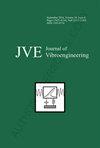Improved theoretical calculation method for the transverse load distribution of wide bridges considering torsion and distortion
IF 0.7
Q4 ENGINEERING, MECHANICAL
引用次数: 0
Abstract
An improved theoretical calculation method was proposed to determine the transverse load distribution of airport and highway bridges under heavy loads using the rigid-joint girder (RJG) method. The effects of torsion, distortion, and vertical inclination of the adjacent box girder joints under an eccentric heavy load were considered. The coefficients and influence lines of a taxiway bridge and a highway bridge were calculated using the proposed method, the RJG method, and the modified RJG methods. The accuracies of the three methods were evaluated by the refined finite element model, and the cosine similarity and peak deviation rate were used as quantitative indices. The results showed that the cosine similarity obtained from the proposed method for the taxiway bridge was 0.996 compared with the finite element method (FEM). The maximum peak deviation rate of the transverse load distribution coefficient for the proposed method was 14.88 % and obviously lower than 34.74 % for the RJG method. For the highway bridge, the cosine similarity of the influence line derived from the proposed method was 0.995, and the maximum peak deviation rate of the transverse load distribution coefficient for the proposed method was 6.66 % and lower than 16.14 % for the RJG method. The results indicate that the proposed method can be used to calculate the transverse load distribution of wide box girder bridges accurately and efficiently.考虑扭转和变形的宽桥横向荷载分布的改进理论计算方法
提出了一种改进的理论计算方法,利用刚接梁法(RJG)确定重荷载下机场和公路桥梁的横向荷载分布。考虑了偏心重载下相邻箱梁接缝的扭转、变形和垂直倾斜的影响。使用提出的方法、RJG 方法和改进的 RJG 方法计算了滑行道桥和公路桥的系数和影响线。通过改进的有限元模型对三种方法的精确度进行了评估,并将余弦相似度和峰值偏差率作为定量指标。结果表明,与有限元方法(FEM)相比,拟议方法获得的滑行道桥梁余弦相似度为 0.996。建议方法的横向荷载分布系数最大峰值偏差率为 14.88%,明显低于 RJG 方法的 34.74%。对于公路桥梁,建议方法得出的影响线余弦相似度为 0.995,建议方法的横向荷载分布系数最大峰值偏差率为 6.66%,低于 RJG 方法的 16.14%。结果表明,建议的方法可用于准确、高效地计算宽箱梁桥梁的横向荷载分布。
本文章由计算机程序翻译,如有差异,请以英文原文为准。
求助全文
约1分钟内获得全文
求助全文
来源期刊

Journal of Vibroengineering
工程技术-工程:机械
CiteScore
1.70
自引率
0.00%
发文量
97
审稿时长
4.5 months
期刊介绍:
Journal of VIBROENGINEERING (JVE) ISSN 1392-8716 is a prestigious peer reviewed International Journal specializing in theoretical and practical aspects of Vibration Engineering. It is indexed in ESCI and other major databases. Published every 1.5 months (8 times yearly), the journal attracts attention from the International Engineering Community.
 求助内容:
求助内容: 应助结果提醒方式:
应助结果提醒方式:


